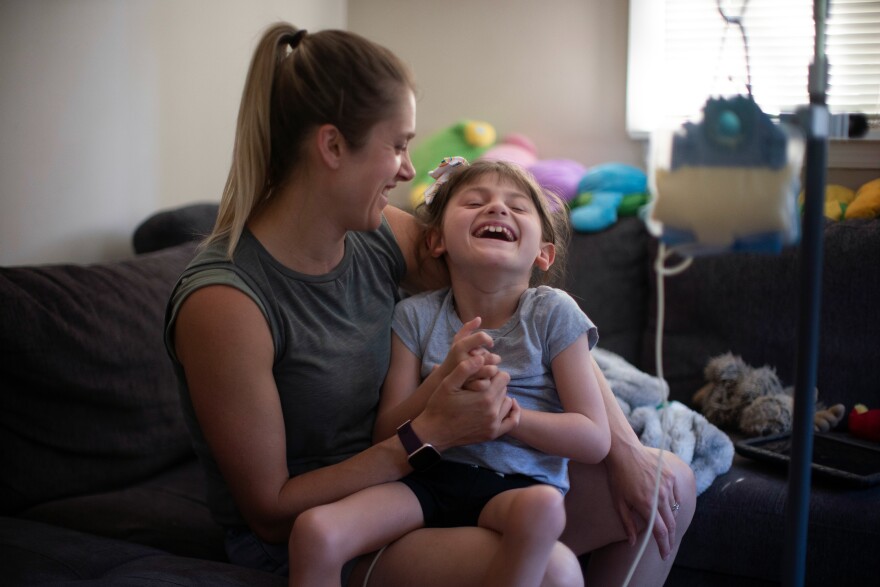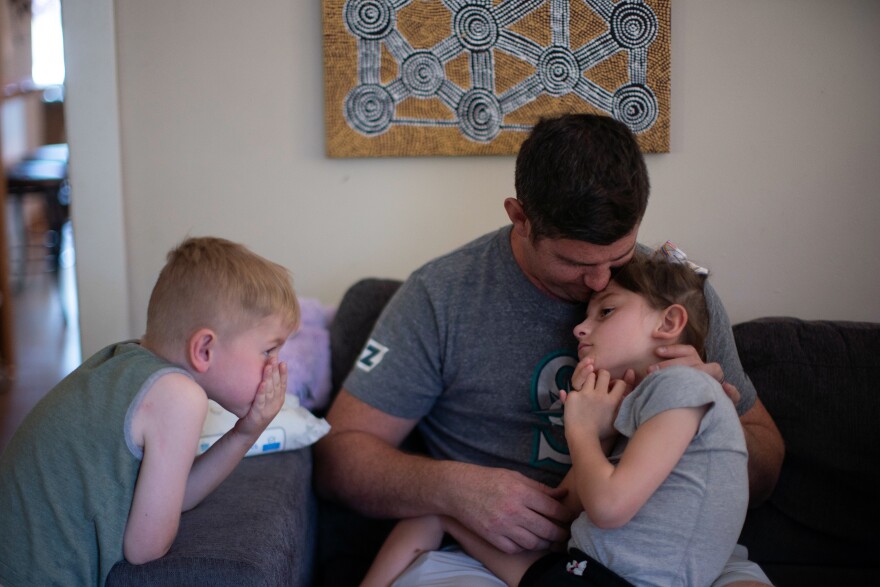Seven-year-old Winnie Hoyt sits nestled in her mother's lap in a therapy room at Oregon Health and Science University in Portland. She's dressed in a lavender romper that sets off her soft brown eyes, and smacks her lips occasionally while her mom and her speech-language pathologist fiddle with settings on an iPad-like device hovering in her line of sight.
After some adjustments, Winnie flicks her eyes over to the right spot and the two women cheer when Moana's "You're Welcome" starts to play.
A year into these appointments, Winnie is finally getting comfortable with this "eye gaze" device. A small camera tracks her pupils so she can use them like a mouse to make selections on the screen. Winnie was born with a rare genetic condition that impairs her ability to walk and speak, and her parents are hoping this new technology can give her a voice.
"Our biggest goal in life is to get Winnie her 'yes/no,' " mom Jenny Eckart Hoyt said. "We know that communication will follow once she's able to make all her choices."
This eye gaze technology plays an important role in helping Winnie communicate, but only if she has opportunities to freely explore it with a trained instructor, "kind of like she is right now," explained her speech-language pathologist, Stephanie Crawford.
Unfortunately, those opportunities have been limited. Winnie's school district, Portland Public Schools (PPS), does have an eye gaze machine, but her mom said Winnie is only able to work on it about 30 minutes a week at school due to staffing.
It could be more. Because of her disability, Winnie qualifies for Medicaid. The federal program could help pay to get her more practice time with the eye gaze — but PPS stopped billing Medicaid years ago. In an email to NPR last spring, the district said the cumbersome billing "took time away from providing critical and time-sensitive services in schools."
Now, Portland and many other school districts around the country have a new opportunity to recoup millions or even billions in healthcare costs. Medicaid officials hope they'll take it.
Medicaid and the Children's Health Insurance Program, better known as CHIP, covers over 42 million kids because of their family's low income or, like Winnie, due to disability. A lot of their healthcare is provided through clinics and hospitals, but for decades Medicaid has also allowed schools to bill for certain health services they provide.
In 2022, federal and state Medicaid programs spent $6.6 billion in schools — mostly for services provided to students with disabilities, like Winnie, such as nursing or speech therapy.
But Medicaid officials want schools to know the program can also pitch in for things like mental health services and treatments for common ailments like asthma and diabetes. In May, the public health insurance program announced new guidance that has the potential to massively expand payments for healthcare in schools — but only if schools and states step up.

Dan Tsai, deputy administrator and director of the Center for Medicaid & CHIP Services, said the new guidance is designed to streamline the process of school-based billing and increase students' access to healthcare.
"You can imagine various barriers where you have a single working parent with a young child trying to find a way to get to a doctor's appointment in the middle of the day, for a routine wellness visit or screening," Tsai said. "Now, imagine that can actually be provided in the school setting."
Children could get healthcare without leaving school, and schools could get millions of dollars more for health specialists and services.
"It's not only efficient, but it's probably one of the most effective ways we can reach a broad set of populations — in particular, kids and school-age youth who are in underserved communities," Tsai said.
Schools and states are leaving millions on the table
Because Medicaid is a state-federal partnership, participation — and financing — can vary widely.
In 2021, Texas reported getting $741 million from the federal program for school-based health care and Medicaid-related activities, such as getting kids signed up. Chicago Public Schools, the nation's fourth-largest school district with 322,000 students, said it gets about $40 million a year from Medicaid. Meanwhile, schools in Wyoming couldn't start billing for any school-based services until 2022.
It's hard to know how many U.S. schools are already billing Medicaid. In a recent survey, University of Washington researcher Mayumi Willgerodt put that question to school nurses. Out of 2,428 responses, 34% said their schools did not bill and 42% confirmed they did. The rest were uncertain. Willgerodt estimated a little more than half of the country's schools bill some services to Medicaid. The yeses were more common in the West and Midwest, and less common in the South and Northeast.
All 50 states can currently bill Medicaid for medical services provided to students with disabilities in schools. But in order for schools to also bill for Medicaid-enrolled low-income students — and thus more fully take advantage of the changes announced in May — states need to take action by updating their Medicaid plans and/or updating state-level policies.

A spokesperson for the Centers for Medicare & Medicaid Services said 14 states, including Oregon and Illinois, have already updated their Medicaid plans with the federal government. He could not confirm the additional number of states that have updated their state-level policies, but the Healthy Schools Campaign, which advocates for broader Medicaid funding in schools, put that number at eight.
Tsai hopes other states will soon follow.
"We're establishing a federal framework," Tsai said. "If none of the states want to make it more flexible for schools to utilize this, we can't force them to."
How much money might schools be missing out on? "You're talking about things on the order of magnitude of billions," Tsai said.
Medicaid has been filling a need for special education funding — but it isn't easy to tap into
Since 1975, the Individuals with Disabilities Education Act (IDEA) has guaranteed children the right to a free public education, even if they have a disability that makes their education more expensive than average. Congress promised to fund 40% of those needs, but it's never even come close. In 2020, the National Education Association calculated the rate was just 13.2%.
Since 1988, Medicaid has slowly – though not completely – helped backfill for that lack of funding, allowing schools to get reimbursed for certain IDEA-required services, such as physical therapy for a child in a wheelchair.
But schools aren't always taking advantage.
Despite months of inquiries to districts in Oregon and across the nation, few officials would speak plainly and on the record about what's stopping them.
In an unsigned, emailed statement last spring, Winnie's school district, Portland Public Schools, described numerous barriers. Primary among them: The staff didn't think the burdensome process was worth it.
Wendy Niskanen, a board member for the National Association of School Nurses, echoed that concern: "Right now, the barriers are too great for most districts to do it."
Niskanen said schools aren't doctors offices, so they're not set up with the right training or software to do the kind of billing and documentation Medicaid requires.
It's a complaint Medicaid officials like Dan Tsai have heard from districts around the country.
"You have to bill for healthcare services in the same way that a hospital or a doctors office would bill, and most schools ... don't happen to have a medical expert coder sitting around."
The changes Tsai and his team announced in May are meant to help address these challenges.
Technology could be key
Niskanen said health providers in schools need a modern and universal electronic records system for Medicaid billing to be worth it.
"We don't want to have to write our treatment in one place and then put it into a portal in another place. We want to be able to have that same system."
One universal system would require a large, initial investment. But Niskanen said figuring out how to efficiently bill Medicaid will pay dividends to the entire student body, regardless of whether they're covered by the program.
Medicaid money can only be spent on kids that it insures, but if new reimbursements paid for, say, half a school nurse or psychologist, the district might be able to swing the other half, and so help all students more.
"It's not just for those students [in special education]. Those students need it. We're required to provide those services for those students," she explained. "But the need is so much broader, and we need to make sure that we're addressing school health so that students can be in school safe and ready to learn."
Niskanen recalled an experience at a conference when nurses erupted in cheers after they learned Georgia had started billing Medicaid "and the amount of funds that they received from doing that completely changed the landscape of school nursing in that state... I get chills just thinking about it. I know this is the solution."
In 2021, Georgia schools received $45.7 million in federal dollars from Medicaid — both for direct services and administrative duties.
Niskanen hopes other schools will follow Georgia's example.
"There's a lot of things that can happen when we don't have funding," she explained. "One of them is to say to a student: 'We don't have a nurse for you. You can't come to school.' "
It's not just nurses. Medicaid can pay for specialists to support children with behavioral or mental health issues. In Oregon, a report by court-appointed experts found about 1,000 children in special education were unable to attend full-time school in the 2019-20 school year, in part due to the lack of appropriate staffing.
"That's a massive violation of civil rights," Niskanen said.
Medicaid funding could help schools expand mental health services
Chicago schools have already been getting tens of millions of dollars from Medicaid. Thanks to a recent update to Illinois' state Medicaid plan, the district can take advantage of the changes Medicaid announced in May and get millions more.
"This is for services already being provided," said Katherine Yager, the school system's billing specialist. Schools already need to offer students diabetes management, medication administration, asthma control and other health care. "And then, as we look outside of that, we'll be looking at things like crisis intervention services, other types of mental and behavioral health supports that the school district also provides."
That was the intention of the federal legislation that brought about this year's Medicaid changes. The Bipartisan Safer Communities Act aims to get more mental health supports into schools to help address gun violence and stem the tide of the youth mental health crisis. That law helped pave the way for new guidance and a technical assistance center that will help ease the billing process for schools.
Jenny Millward, executive director of the National Alliance for Medicaid in Education (NAME), hopes states and schools will act fast to adopt these latest changes.
"My hope is just that with the release of these guidelines and the momentum that we have, in the next three to five years, we're going to be able to expand this program and what it can do across the nation," she said. "Schools might not even know everything that's allowable at the federal level because a lot of times schools operate just within their silo."
Millward said NAME is working hard to push out this information, including that schools could get funding for mental health services.
"With any program, there's going to be administrative work that has to be done to meet the requirements of the program to get your reimbursement," she acknowledged. "I know that that's a concern and likely a big reason why school districts would choose to not participate or to stop participating in the program."
But if schools and states can manage to work together, Millward sees the potential for healthier children whose mental and physical health needs are caught earlier — reducing the need for costly interventions like emergency room visits and 911 calls.

"That would be, to me, the greatest outcome that this could have."
Winnie's mom, Jenny Eckart Hoyt, has another great outcome in mind: Getting her daughter more in-school time with the eye gaze machine and a trained instructor.
That may be close to happening. Because of this year's changes, Portland Public Schools said it now plans to start billing Medicaid again.
It's not yet clear what that will mean for Winnie this school year. But not having to leave school for services would be a big win for the 7-year-old.
When Ekart Hoyt brought her daughter to her classroom last spring, Winnie was smiling and laughing.
"She loves school," her mom said. "There's just no doubt about it."
Digital story written by: Shasta Kearns Moore
Audio story written by: Emily Harris
Edited by: Nicole Cohen
Audio story produced by: Lauren Migaki and Janet Woojeong Lee
Visual design and development by: LA Johnson
Shasta Kearns Moore is a freelance reporter in Portland, Ore., and the mother of twins with disabilities. She publishes a weekly round-up of news relevant to those raising disabled and neurodivergent kids at MedicalMotherhood.com.
Emily Harris is a former NPR correspondent now covering her hometown of Portland, Ore., for Axios Local.
Copyright 2023 NPR. To see more, visit https://www.npr.org.



